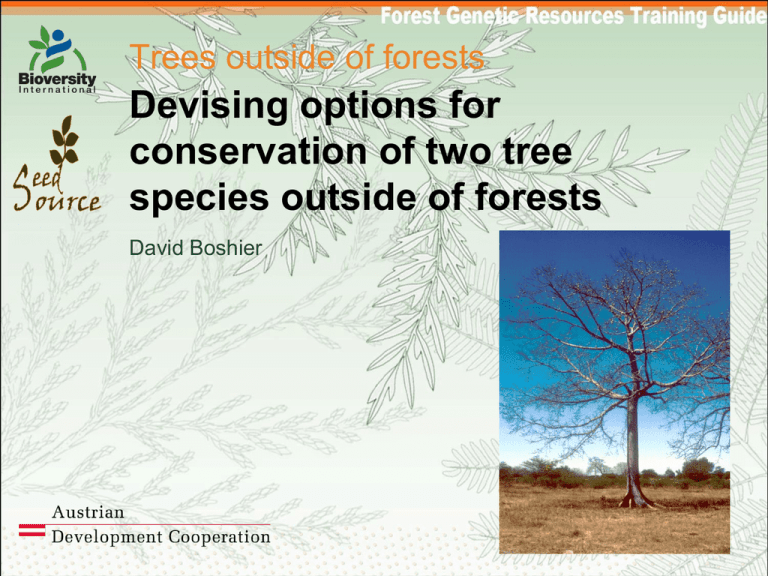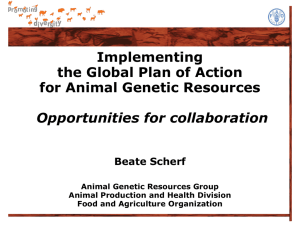PPT - Forest Genetic Resources Training Guide
advertisement

Trees outside of forests Devising options for conservation of two tree species outside of forests David Boshier What are the impacts of human interventions on trees? What are the genetic impacts of human interventions on trees? Examples from other classes impacts of human interventions on trees? fragmentation, afforestation, silviculture, deforestation, agriculture, shifting cultivation, premature death, clear fell genetic impacts of human interventions on trees? hybridisation, inbreeding depression, dysgenic selection, loss of genetic diversity, species loss, increase variance between populations, genetic loss/erosion Genetic impacts of human interventions on trees Humans impact forests in a variety of ways, eg • conversion of forest to agriculture & other uses • forest fragmentation • logging, harvesting of different types • domestication/breeding Need to consider influence of interventions on functionality of tree populations & relevance to conservation Genetic impacts of human interventions on trees All interventions influence genetic diversity of trees to greater or lesser extent In many circumstances impacts on genetic diversity may not be a priority Foresters/conservation managers need to be able to identify – how patterns of genetic variation are altered – under what sort of circumstances genetic diversity and its loss may become limiting Where & how should we conserve? In situ - Ex situ In situ - reserve system of undisturbed, protected areas within natural distribution (ecosystem based) Ex situ - artificial maintenance of populations outside natural distribution (species based) 6 Impacts of human disturbance not random • often superimposed on habitat heterogeneity • may lose species and populations adapted to lowlands/good soils Conservation of biodiversity in situ: trees as a paradigm ideal reserve model emphasis: large, continuous, protected areas limitations: location, size, security, biology: – – – – movement of animals extensive distribution of many species gene flow between populations upland, non agricultural areas essential but not sufficient Where should we conserve? In situ - Ex situ In situ - reserve system of undisturbed, protected areas within natural distribution (ecosystem based) Ex situ - artificial maintenance of populations outside natural distribution (species based) 10 Conservation of biodiversity ex situ: methods and limitations seed banks - problems of regeneration plantations - changes in gene frequencies, few populations botanical gardens - deficiencies for gene pool conservation 11 © RBG Kew © RBG Kew © DH Boshier a large number of individuals of many species have long ago ceased being ecologically (and evolutionarily) reproductive; they flower but set no These are the deadnever lead to seed, or if they set seed, theliving seedlings 12 Janzen 1986 recruitment of adults. © DH Boshier Issues of concern – conservation of tree genetic resource outside of forests • Conservation of species and genotypes • Conservation paradigms – in situ, ex situ, through use on farms – circa situm • Fragmentation – gene flow patterns and maintenance of viable populations • Reproductive materials: source and collection Theory direct impacts genetic processes decrease pop. size genetic drift increase spatial isolation gene flow decrease densities mating - inbreeding change local environment selection A: Low genetic structure Low genetic differentiation (Gst) y x y z xy z xy z x y x z y xy z xy z z xy z x z Fragmentation xy z y x xy z xy z High genetic differentiation (Gst) B: High genetic structure yy y yy zzz zz z yy y xx x Fragmentation zz xx x yy y xx x zz xx zz yyy yy y xx x yy y A: Drift and extinction: loss of genetic diversity xy z xy z xy z xy z Drift – no gene flow zz z xx x Increased genetic differentiation (Gst) yy y yy y Extinction xx x xx x B: Gene flow reduces loss of genetic diversity xz xy z xy Drift z xy z z gene flow xx xy y xy z xy y z xy z Extinction xx y Reduced genetic differentiation (Gst) A: fragmentation with drift among isolates y xy z x xy y z z z x y xy z y xx y z x y zz z xz z z yy x xx y z High genetic differentiation (Gst) yy y xx x xx x xx z x B: fragmentation with gene flow via ‘isolated’ trees y xy z x xy y z z z y xy z xx y z x y x y z xy z y z xy z z x x x z xy z xy z y xy z xy z x xy z xy z x Low genetic differentiation (Gst) Range of land-use systems may be important for long term genetic viability of some tree species through – conservation of particular genotypes not found in reserves – facilitation of gene flow between existing reserves – maintenance of MVPs (Minimum Viable Populations) – intermediaries & alternate hosts for pollinators & seed dispersers Broad vision of corridors - mosaic of land-uses that promote connectivity & conservation of biodiversity more generally Isolated trees – can we collect seed? Altered mating patterns in fragments Predictions: increased inbreeding greater pollen dispersal fewer sires sires inbreeding dispersal Isolated tree Continuous forest Can valuable tree genetic resources persist outside of forests and if so what measures need to be taken to ensure they persist? Swietenia humilis – IUCN listed as vulnerable, also on CITES appendix II monoecious flowers, self-incompatible, bee pollinated, wind dispersed Swietenia humilis White, Boshier & Powell, 2002 trees sampled at Punta Ratón, Honduras Pollen flow into fragments Swietenia humilis Fragment Las Tablas* El Jicaríto Cerro El Jiote Tablas Plains Tree 501** Fragment “size” 97 44 22 8 1 % pollen from outside 36.0 47.0 38.3 68.4 100.0 * part of continuous forest, surrounded by unsampled trees ** an “isolated” tree White, Boshier & Powell, 2002 Frequency of pollen flow to S. humilis trees in Cerro Jiote fragment and to an “isolated” tree, Honduras Pollen donors C. Jiote 0.8 0.4 0 0.3-0.6 0.9-1.2 Distance, km >1.5 Pollen donors ‘Isolated’ tree 0.8 0.4 White, Boshier & Powell, 2002 0 0.9-1.2 2.1-2.4 Distance, km 3.3-3.6 4.5 >20 trees selfed no seed Pachira quinata Central + South America Deciduous tree Hermaphrodite flowers Self-incompatible Bat (& moth) pollinated Seed + ‘kapok’ wind dispersed Costa Rica: Forest vs Pasture Lomas Barbudal Reserve Stewart Property Forest 1000 Stewart Property SP13 SP12 SP07 SP14 SP08 800 Pasture North (m) SP09 SP15 SP16 600 SP11 SP06 SP04 400 SP01 SP02 SP18 SP03 SP05 SP19 200 SP10 SP17 SP20 0 0 200 400 600 800 1000 West (m) 1200 1400 1600 1800 Results: Forest vs Pasture Site Forest Outcrossing Correlation rate (SE) of tm (SE) 0.926 (0.021) 0.117 (0.045) Number of sires Dispersal distance 3.3 - 4.1 48 metres Results: Forest vs Pasture Site Outcrossing Correlation rate (SE) of tm (SE) Number of sires Dispersal distance Forest 0.926 (0.021) 0.117 (0.045) 3.3 - 4.1 48 metres Pasture 0.828 (0.085) 0.636 (0.148) 2.9 - 4.4 158 metres Lower outcrossing & greater dispersal but not fewer sires in the pasture Results: Forest vs Pasture Site Outcrossing Correlation rate (SE) of tm (SE) Forest 0.926 (0.021) Fuchs Forest 0.915 (0.043) Pasture 0.828 (0.085) Fuchs Pasture 0.777 (0.114) 0.117 (0.045) Number of sires Dispersal distance 3.3 - 4.1 48 metres 1.8 - 2.6 0.636 (0.148) 2.9 - 4.4 158 metres 1.2 - 1.6 Fuchs et al 2003 suggest isolated (>500m) pasture trees receive less outcrossed pollen Costa Rica: Pasture 1000 Stewart Property SP13 SP12 SP07 SP14 SP08 800 Isolated by 350m North (m) SP09 SP15 SP16 600 SP11 SP06 SP04 400 29% SP01 SP02 SP03 82% 51% 71% SP18 SP05 SP19 200 SP10 SP17 SP20 29% 20% 0 0 200 400 600 800 1000 1200 West (m) Predict that selfing will increase with isolation But it doesn’t! 1400 1600 1800 Self-incompatibility system Reduced germination of self pollen –Slower growth rate of self pollen Pollen reaching ovary Self Cross 48 hours 15% 56% 72 hours 64% 90% 120 hours 89% 90% Ability to self varies among trees – – 50% non-selfers 12.5% selfers WCMC World List of Threatened Trees (IUCN Red List categories of threat) http://www.wcmc.org.uk/trees/Background/intro.htm 9% of world's tree flora globally threatened with extinction accuracy of assessment? S. humilis P. quinata - IUCN vulnerable not listed this study ? ? Your task Derive an action plan to ensure effective conservation and use of both species outside of forests









